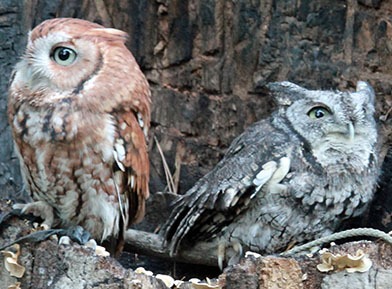The eastern screech owl (Megascops asio) can be found in forested areas east of the Rocky Mountains. It is one of our smaller owls – only about as long as a cardinal from the tip of its head to the tip of its tail, although the screech owl is much stockier than the cardinal. There are two different color morphs of the eastern screech owl – a red morph and a grey morph. The red morph is more common in the southeastern part of the country; however, it can be found throughout most of the screech owl’s range.
Regardless of the color morph, eastern screech owls are very well camouflaged and at first glance can almost disappear against a tree trunk. Their camouflage helps them remain hidden during the day when they are resting. Chickadees, wrens, titmice, blue jays and several other songbirds will harass and try to drive off any screech owls they find.

The diets of eastern screech owls are very diverse. Small songbirds, bats, small mammals, and large insects are common menu items. They have also been known to catch and eat small fish and tadpoles that were close to the surface, lizards, frogs, earthworms, and many other animals.
Eastern screech owls can make several different calls, but they only have two songs – a whinny and a trill. Both males and females will sing and mated pairs will often sing together. Because screech owls hunt at night and stay hidden during the day, it is often easier to hear a screech owl than it is to see one.
Mating typically occurs in March or April, but can sometimes occur in May. Eastern screech owls nest in abandoned woodpecker cavities, tree hollows created by fungus, and similar cavities. They will also use nest boxes. (Instructions for how to build a screech owl nest box can be found on Cornel’s Project NestWatch website.) Females don’t gather nesting material to build a traditional nest. Instead, the female will just create a depression in whatever debris is already in the cavity. Typically, she will lay between 2 and 6 eggs.
The female incubates the eggs for approximately a month during which time the male will bring her food. After the eggs hatch, the young remain in the nest for approximately another month. The male brings most of the food that the nestlings eat. Once the nestlings fledge, they will stay with their parents for approximately two more months during which time both parents feed the young.
One really cool nesting behavior that is exhibited by eastern screech owls is that they will sometimes bring live blind snakes back to the nest! Blind snakes are small snakes, about the size of an earthworm. It’s not unusual for this tiny snake to climb trees and hunt for insects in tree cavities. However, eastern screech owls have been observed bringing these snake to their nesting cavities and releasing the snakes into the nests. The snakes burrow into the nesting debris, and it is thought that the snakes feed on insects that might otherwise feed on the nestlings. Research has even shown that nestlings raised in nests with blind snakes are healthier than nearby nestlings that didn’t grow up with blind snakes in their nest.
Although their nocturnal behavior makes them harder to spot, eastern screech owls are commonly found in wooded backyards in rural, suburban, and urban areas. In fact, some research indicates that eastern screech owls do better in urban areas than in rural areas. Some of the reason why this might be true include greater prey densities, slightly warmer temperatures, and reduced predators. So regardless of whether you live in town or in the middle of nowhere, as long as there are trees around there is a good chance that you might have an eastern screech owl in the neighborhood.

This article was part of Shannon’s original Kentucky Pollinators and Backyard Wildlife blog which evolved into the blog for Backyard Ecology.

Backyard Ecology: Exploring Nature in Your Backyard
Nature isn’t just “out there.” It’s all around us, including right outside our doors. Hi, my name is Shannon Trimboli, and I am the host of Backyard Ecology. I live in southcentral Kentucky and am a wildlife biologist, educator, author, beekeeper, and owner of a nursery specializing in plants for pollinators and wildlife conservation. I invite you to join me as we ignite our curiosity and natural wonder, explore our yards and communities, and improve our local pollinator and wildlife habitat. Learn more or subscribe to my email list at www.backyardecology.net.

Leave a Reply